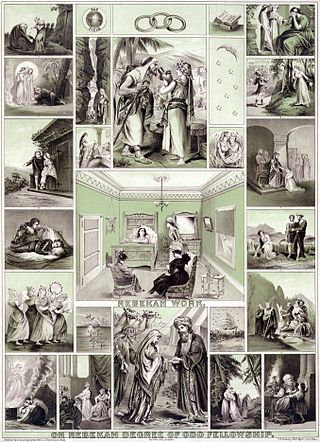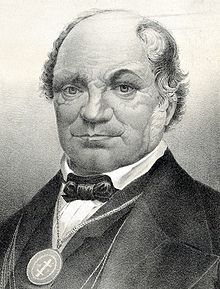
The Independent Order of Odd Fellows (IOOF) is a non-political, non-sectarian international fraternal order of Odd Fellowship. It was founded in 1819 by Thomas Wildey in Baltimore, Maryland, United States. Evolving from the Order of Odd Fellows founded in England during the 18th century, the IOOF was originally chartered by the Independent Order of Oddfellows Manchester Unity in England but has operated as an independent organization since 1842, although it maintains an inter-fraternal relationship with the English Order. The order is also known as the Triple Link Fraternity, referring to the order's "Triple Links" symbol, alluding to its motto "Friendship, Love and Truth".

The Independent Order of Oddfellows Manchester Unity Friendly Society Limited, also called the Manchester Unity of Oddfellows; trading as The Oddfellows, is a fraternal order founded in Manchester in 1810.

A benefit society, fraternal benefit society, fraternal benefit order, friendly society, or mutual aid society is a society, an organization or a voluntary association formed to provide mutual aid, benefit, for instance insurance for relief from sundry difficulties. Such organizations may be formally organized with charters and established customs, or may arise ad hoc to meet unique needs of a particular time and place.

The Daughters of Rebekah, also known as the Rebekahs and the International Association of Rebekah Assemblies, is an international service-oriented organization and a branch of the Independent Order of Odd Fellows. As the Independent Order of Odd Fellows, the Rebekahs began as an all-white organization, typical at the time, that purported to promote reciprocity and charity, and drew inspiration from Judeo-Christian ethics.

Thomas Wildey (1782–1861) was the founder of the Independent Order of Odd Fellows (IOOF) in North America.
A fraternal order is a fraternity organised as an order, with traits alluding to religious, chivalric or pseudo-chivalric orders, guilds, or secret societies. Contemporary fraternal orders typically have secular purposes, including social, cultural and mutually beneficial or charitable aims. Many friendly societies, benefit societies and mutual organisations take the form of a fraternal order.

Insignia Financial Ltd is an Australian financial services company that originated with the Independent Order of Odd Fellows and was formerly known as IOOF Holdings Ltd. It provides clients with a range of financial services including financial advice, investment management, superannuation and estate and trustee services. It is listed on the ASX 200.
Odd Fellows Hall, Independent Order of Odd Fellows Building, IOOF Building, Odd Fellows Lodge and similar terms are phrases used to refer to buildings that house chapters of the Independent Order of Odd Fellows fraternal organization. More specifically, these terms may refer to:

The Ancient Free and Accepted Masons Lodge 687, also known as the Independent Order of Odd Fellows J.R. Scruggs Lodge 372, is a building constructed in 1876 as a Masonic Hall. It is located in downtown Orangeville, Illinois, a small village in Stephenson County. The building, originally built by the local Masonic Lodge, was bought by the locally more numerous Independent Order of Oddfellows fraternal organization in 1893. The building has served all of Orangeville's fraternal organizations for more than 125 years, from the time it was built. The two-story, front gabled building has Italianate architecture elements. It had a rear wing added to it in 1903. By 2003, the first floor has been returned to use as a community center, holding dinner theatre and other community functions, much as the building had originally served the community until first floor space was rented out for commercial use in the late 19th century. The building was listed on the U.S. National Register of Historic Places in 2003. The building is the home of the Mighty Richmond Players Dinner Theatre (MRPDT) dinner theatre which seats 54 persons and has scheduled four different productions for the 2010 season. A $150,000 renovation of the building was recently completed. The building was listed on the National Register of Historic Places as AF and AM Lodge 687, Orangeville in 2003.

The Grand Theatre is part of a complex of historic buildings in Salem, Oregon, United States that was originally owned by the fraternal organization Independent Order of Odd Fellows, and listed on the National Register of Historic Places (NRHP) as the Chemeketa Lodge No. 1, Odd Fellows Buildings. The theater building is also known as the I.O.O.F. Temple.

A fraternity or fraternal organization is an organization, society, club or fraternal order traditionally of men associated together for various religious or secular aims. Fraternity in the Western concept developed in the Christian context, notably with the religious orders in the Catholic Church during the Middle Ages. The concept was eventually further extended with medieval confraternities and guilds. In the early modern era, these were followed by fraternal orders such as Freemasons, the Rosicrucian Society of England, and Odd Fellows, along with gentlemen's clubs, student fraternities, and fraternal service organizations. Members are occasionally referred to as a brother or – usually in a religious context – frater or friar.
IOOF Building may refer to two buildings in the centre of the city of Adelaide, South Australia. The first was built in the late 19th century and was demolished in the early-mid 1960s. As a result of this, the second was built as a "replacement" in the mid 1960s.
Odd Fellows or Oddfellows is an international fraternity and its members.

The Grand United Order of Odd Fellows, American Jurisdiction is a jurisdiction of the Grand United Order of Oddfellows in the United States, Jamaica, Canada, South America, and other locations. Since its founding in 1843, its membership has principally included African Americans, due to their being discriminated against in most other fraternal orders in America at the time.
Grand United Order of Oddfellows Friendly Society (GUOOFS) is an odd fellows grand lodge founded in 1798 and based in Manchester, England.
The Golden Age of Fraternalism is a term referring to a period when membership in the fraternal societies in the United States grew at a very rapid pace in the latter third of the 19th century and continuing into the first part of the 20th. At its peak, it was suggested that as much as 40% of the adult male population held membership in at least one fraternal order.
Australian Unity is an Australian mutual company having its origins in the friendly societies movement. In 2012, Big Sky was merged with Australian Unity to become the banking arm of the company.

James Lot Ridgely was an American lawyer and politician from Baltimore, Maryland, who has been called "the father of modern, ethical Odd Fellowship".
















